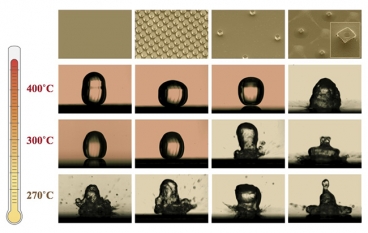MIT researchers make surfaces that are easier to cool under extreme heat; finding could benefit power plants, electronics.

Micrographs showing water droplets landing on specially designed silicon surfaces (top images) at different temperatures. At higher temperatures, the droplets begin to exhibit a new behavior: instead of boiling, they bounce on a layer of vapor, never really wetting and cooling the surface. At 400 C, the droplet continues to boil only on the surface that combines microscale posts with a coating of nanoscale particles (last column). These results demonstrate that this micro‑nano surface can be effectively cooled even at high temperatures. Graphic courtesy of the researchers and Adam Paxson.